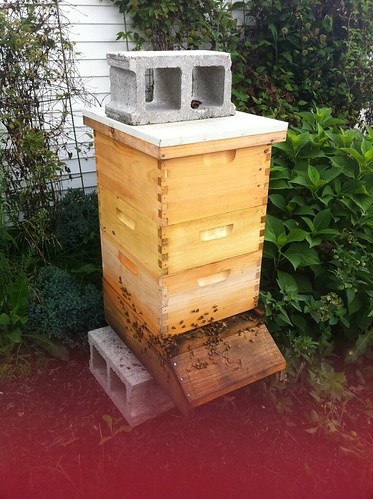Covered In Bees: Who Doesn't Like Bees?
So to sum up, for those just arriving: our bees have had a rather tumultuous start this year thanks to mistakes we’ve made as novice beekeepers:
1) We didn’t realize there was an old queen in the box of bees we got (her tiny cage was lost in a mass of other bees when we dumped them in), and as such the new queen we introduced was stung to death while the old queen was still trapped in her cage, unable to lay. This set our bees back by about a week.
2) When the bees stopped eating the sugar syrup we gave to them, we thought they were full up and stopped feeding them. As it turned out, there was a heavy nectar flow that week, and the bees prefer actual food – but when that nectar flow stopped, our bees weren’t necessarily starving, but not fully-fed enough to build a colony from scratch.
The whole cycle of Ohio bees is one steady, constant goal: survive winter. They’re out there gathering honey so when the cold winds come and all the plants die, they have enough food to live on. Gathering honey requires a queen to lay enough eggs so that they have the workers to gather the pollen and nectar, and the workers bees to build a lot of wax comb to store the honey in safely, and enough flowering plants to harvest from. If any of these fails, the bees can’t achieve critical mass and they starve to death, or freeze to death.
Given that we were starting from zero, dumping the bees into an empty box, this year’s had tension. We feel responsible for the bees. We brought them all the way out here from California, and if they don’t make it it’s our fault. So our out-of-the-box errors feel like we’re killing innocent creatures.
Fortunately, we’ve been feeding the crap out of them and they seem to be responding, so now comes the next step: the honey super.
The honey super is when we take the training wheels off – they have enough honey to survive the winter, so now we put a smaller box on top that the bees will, hopefully, store their excess honey in. In a month or two, we take off the box and harvest it, via a rather sticky method that we’ll doubtless need help with.
Does this mean we’ll get any honey? Who knows? Our beekeeping has been a little crazy. We might get a little. At this point, we’re not doing it for the honey, we’re doing it to shelter our very strange and fuzzy pets.
In any case, you can watch us trying to get into the hive here, and failing because holy crap the bees have sealed everything up with propolis:
And here is the second video of us looking at the top – look at all that honey! That looks like more than enough to me, maybe a little too much.
There’s one other video of us after this, but it refuses to upload to YouTube – and it’s not that interesting anyway, since at this point the bees were starting to get riled and we stopped prematurely. (It was a cloudy day, which bees do not like, and hence a bad day to be in the hive – but the weather this week isn’t good, and we needed to get that honey super in there.)
The honey super is currently wedged in between the two “living” bee supers, because we want to encourage the bees to build some comb in there. Once it’s firmly established – say, a week – we’ll rearrange the boxes and put the honey super back on top. It currently looks like this:

The thing that still amazes me is that I pulled a muscle in my back lifting that box of bees. They told me that bee boxes could get to eighty pounds, but that seemed crazy – when I dumped the bees in, they weighed three pounds. (Which, at the time, seemed like a lot of bees.) And, when you have a box of goddamned stinging bees in your hands, you can’t afford to drop it. My back still aches, and we’re ordering a “placeholder” super that we can lift frames out and put them back in, just to lighten the load.
Still a cool hobby, though.


Hi Ferrett! This makes me jealous that I don’t have the space to try raising my own. Do you have to cover the hives in winter? And I couldn’t always tell what I was looking at in the videos — Are the frames completely empty when they’re new, or is there some surface running across them for the bees to build the combs on?
a) We do not have to cover the hives in winter, though some do. We have a back yard that’s largely windbroken.
b) The frames we use are plastic, rubbed in bees’ wax to encourage the bees to build. You can use leaf-thin panes of wax, but they break very easily. If you go to my earlier videos, we spend more time on the bees, which should give you a better idea of what we’re working for – just this time, we wound up zipping over because we had too much to do and too little time.
c) There’s a lot of rooftop beekeeping in NYC. If you’re interested, maybe you could talk to your landlord – you have about six months to prepare!